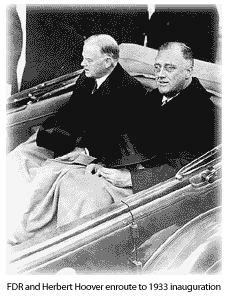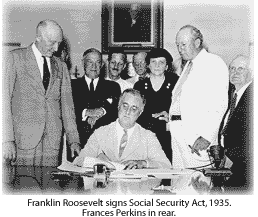At the age of 51, Franklin D. Roosevelt was inaugurated president on March 4, 1933. The ceremony was the last to be held in March. All subsequent inaugurations have been held in January, under Amendment 20 to the Constitution (text).
 The depression had relentlessly worsened. Bread lines were commonplace as thousands of jobless people waited to obtain food for their families. Both farmers and city workers had become homeless, and more would lose their homes because they could not afford their mortgage payments. In all of this, FDR delivered his first inaugural address, which began:
The depression had relentlessly worsened. Bread lines were commonplace as thousands of jobless people waited to obtain food for their families. Both farmers and city workers had become homeless, and more would lose their homes because they could not afford their mortgage payments. In all of this, FDR delivered his first inaugural address, which began:
This is a day of national consecration. And I am certain that on this day my fellow Americans expect that on my induction into the Presidency, I will address them with a candor and a decision which the present situation of our people impels. This is preeminently the time to speak the truth, the whole truth, frankly and boldly. Nor need we shrink from honestly facing conditions in our country today. This great Nation will endure, as it has endured, will revive and will prosper. So, first of all, let me assert my firm belief that the only thing we have to fear is fear itself -- nameless, unreasoning, unjustified terror which paralyzes needed efforts to convert retreat into advance. In every dark hour of our national life, a leadership of frankness and of vigor has met with that understanding and support of the people themselves which is essential to victory. And I am convinced that you will again give that support to leadership in these critical days.
Domestic Affairs
The Banking Crisis. A banking panic sparked into flame about three weeks before the inauguration. Like a prairie fire, it spread throughout the nation as alarmed customers rushed to their banks to empty their accounts. The panic ruined numerous banks. On the day before Roosevelt took office, more than 5,000 banks went under.
The new president announced a "bank holiday" on March 6, 1933, and closed every bank in the country. They would remain closed until Department of the Treasury officials could inspect each institution`s ledgers. Banks in viable financial condition would be primed with Treasury money and permitted to do business again. Those found in marginal condition were kept closed until they could be restored to a sound footing. Numerous banks that had been poorly run remained closed forever.
Roosevelt`s decisive action revived public confidence in the banks and ended the crisis. Most people were persuaded that if a bank reopened, it was sound.
One Hundred Days. The president called a special session of Congress on March 9. Immediately he began to submit reform and recovery measures for congressional validation. Virtually all the important bills he proposed were enacted by Congress. The 99-day (March 9-June 16) session came to be known as the "Hundred Days."
Among the measures enacted were the following:
Many of Roosevelt`s presidential campaign advisors continued to counsel him after he was elected, among them Adolf A. Berle, Harry L. Hopkins, Raymond Moley, Samuel I. Rosenman and Rexford G. Tugwell. Collectively, they were dubbed "Roosevelt`s Brain Trust" by a journalist.
Roosevelt`s Cabinet included the first woman ever named to that body, Frances Perkins, who became secretary of labor. Perkins was commissioned by the president to design an insurance program to aid workers following their work years. Her efforts resulted in the creation of the Social Security Act of 1935, which provided pensions to retired workers.
 The New Deal. So called by the president for his progressive proposals in an effort to end the Great Depression and reform the nation`s economy. The New Deal constituted a wide array of endeavors. Roosevelt summarized it as a "use of the authority of government as an organized form of self-help for all classes and groups and sections of our country."
The New Deal. So called by the president for his progressive proposals in an effort to end the Great Depression and reform the nation`s economy. The New Deal constituted a wide array of endeavors. Roosevelt summarized it as a "use of the authority of government as an organized form of self-help for all classes and groups and sections of our country."
Following Roosevelt`s lead, the government launched a relief program, the Civil Works Administration (CWA), in winter 1933-1934. The CWA provided funds to such authorities as mayors and governors for public projects including road, bridge, and school construction, park restoration and others. Critics castigated the CWA as make-work, much of it useless.
After a few months, Roosevelt terminated the CWA, but other programs enjoyed longer lives. The Civilian Conservation Corps (CCC) lasted from 1933 until 1942. Its members produced notable and lasting results with flood control, Soil Conservation and forestry programs. The Works Progress Administration (WPA) was established in 1935 to provide work for the unemployed. Between that year and 1941, the WPA employed an average of two million people a year.
During Roosevelt`s first year as president, Congress passed laws to protect stock and bond investors. Small businesses, homeowners and the oil and railroad industries were given help by other legislation. The Social Security Act of 1935 brought unemployment relief and old-age assistance to millions. Workers were given the right to bargain collectively through the National Labor Relations Act of 1935.
The foregoing projects, and others, were expensive, and the government was not taking in enough revenue to avoid deficit spending. The deficit was made up in part by raising taxes and borrowing money through the sale of government bonds. Meanwhile, the national debt climbed to unprecedented heights.
By 1934, the New Deal was encountering opposition from both ends of the political spectrum. All around the country, brazen unions — some Marxist-influenced — sparked job actions, including a city-wide strike in San Francisco. Nevertheless, the most prominent left-wing threat to Roosevelt was a Louisiana senator, Huey P. Long, who railed at the New Deal for not doing enough. Conservatives argued that Roosevelt had done too much. Some of them organized the American Liberty League in August 1934 to galvanize the right. However, in the mid-term elections, the Democrats gained enough seats in both houses of Congress to enjoy veto-proof majorities.
Foreign Affairs
Good Neighbor Policy. "A good neighbor" is how President Roosevelt characterized his administration`s foreign policy. In time, the term would summarize the U.S. stance toward countries in Latin America, but it had effects elsewhere. The United States assumed a leadership role in encouraging conditions of cooperation that would be helpful in World War II.
The Platt Amendment of 1902 had provided the United States with the prerogative to intervene in Cuban affairs. The government repealed that amendment in May 1934. It also resolved old oil quarrels with Mexico and removed American forces from some Caribbean countries. Between 1934 and 1937, the United States signed reciprocal trade treaties, as well as nonaggression and conciliation treaties, with several Latin American countries.
Using personal diplomacy, Roosevelt journeyed to Cartagena, Colombia, in July 1934, becoming the first U.S. president to visit South America. In 1936, he was present at the Inter-American Conference for the Maintenance of Peace, in Buenos Aires, Argentina.
The trend toward positive hemispheric relations soon included Canada, which eventually inked several reciprocal trade agreements with the U.S.
Elsewhere, independence was voted for the Philippines in 1933, to be official in 1945. Statehood for Hawaii was first taken up by Congress in 1937.
Relations between the United States and Russia had been terminated following the 1917 Russian Revolution. Roosevelt, however, desired that trade relations be rekindled between the two countries. Largely with that in mind, his administration recognized the Soviet government in November 1933. Then the United States and Russia exchanged diplomatic representatives for the first time in 16 years.
The foregoing actions implied a shift from "Big Stick" and "Dollar Diplomacy" towards a greater regard for other peoples, which were more attuned to the United States` traditional tendency towards equality and democracy.
Election of 1936
President Roosevelt was renominated by acclamation at the Democratic National Convention in 1936. Vice President Garner rejoined the ticket. The Republicans chose Governor Alfred M. Landon of Kansas for president and Frank Knox, publisher of the Chicago Daily News, for vice president.
During the campaign, the Republicans accused Roosevelt of not keeping his promise to balance the budget. Roosevelt relied upon the actions taken by his administration to fight the depression as his argument for reelection.
Roosevelt won by a landslide. He garnered 523 electoral votes to Landon`s eight, and won every state in his column except Maine and Vermont.
| Hoover Administration | ||